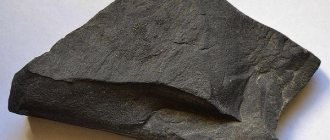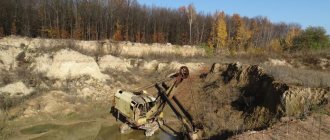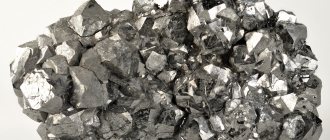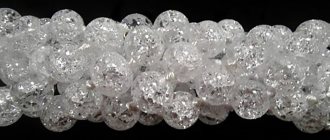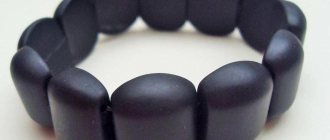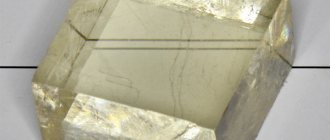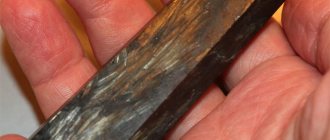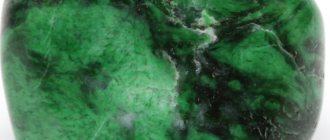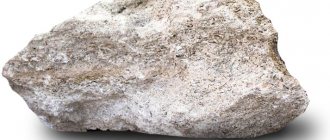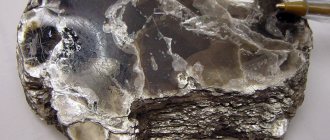Graphite
- a mineral from the class of native elements, one of the allotropic modifications of carbon. A common mineral in nature. It is usually found in the form of individual flakes, plates and clusters, varying in size and graphite content. There are deposits of crystalline graphite associated with igneous rocks or crystalline shales, and cryptocrystalline graphite formed during the metamorphism of coals.
- Structure
- Properties
- Morphology
- Origin
- Application
- Classification
- Physical properties
- Optical properties
- Crystallographic properties
See also:
Agate
- price and medicinal, magical properties
Physical properties and structure of diamond
What is graphite
Everyone knows what graphite looks like. This is the core lead of an ordinary pencil:
- The mineral is soft, which is easy to verify: pencils break due to careless handling.
- It is greasy to the touch and has different hardness and density, as indicated by the brands of pencil - from soft to hard.
- Colors and shades - a full gray range with a matte or metallic sheen.
The layered structure of the mineral creates the ability to write or draw.
Graphite is a mineral, a natural crystalline modification of carbon. Closest relatives are diamond, lonsdaleite, charoite. They are distinguished by their structure. In graphite it is layered.
Graphite can be turned into diamond by heating it to 2000°C and placing it under pressure of hundreds of atmospheres.
In nature, “pure” minerals are not found; rare, valuable metals are found among the impurities.
The production of artificial graphite has been established.
Physical properties of graphite
One of the main properties of graphite is its ability to conduct electric current. Its physical properties differ from those of diamond in that it does not have such a high level of hardness. Its structure is initially quite soft. However, once heated, it becomes hard and brittle. The material begins to crumble.
The physical properties of graphite are as follows:
- does not dissolve in acid.
- Melting of graphite at temperatures below 3800 degrees Celsius is impossible.
- after heating it acquires a hard and brittle structure.
These are not all the properties of graphite. There are also parameters that make this element unique.
Graphite has the following characteristics:
- The melting point of graphite is 3890 degrees Celsius,
- graphite color is dark gray with a metallic sheen,
- The heat capacity of graphite is 0.720 kJ
- The resistivity of graphite is 800.000 · 10 − 8 (Ohm · Meter).
Attention:
The only parameter of all the characteristics of graphite that depends on the type of element is the thermal conductivity of graphite. It is 278.4 to 2435 W/(m*K).
Table. Physical properties of graphite.
| Characteristics | Flow direction | Temperature, °C | ||||
| 20 | 200 | 400 | 600 | 800 | ||
| Thermal conductivity coefficient λ, W/(m°C) of graphite: | ||||||
| - crystalline | || | 354,7 | 308,2 | |||
| - natural | _|_ | 195,4 | 144,2 | 112,8 | 91,9 | 75,6 |
| - pressed | || | 157 | 118,6 | 93,0 | 69,8 | 63,9 |
| - artificial with p=1.76 g/cm3 | _|_ | 104,7 | 81,4 | 69,8 | 58,2 | |
| - the same, with p = 1.55 g/cm3 | || | 130,3 | 102,3 | 79,1 | 63,9 | 53,5 |
| Tensile strength σpts, MN/m2 | || | 14,2 | 15,2 | 15,9 | 16,5 | 17,6 |
| _|_ | 10,3 | 11,3 | 12,0 | 12,5 | 13,7 | |
| Elastic modulus E, MN/m2 | || | 5880 | 7100 | 7350 | 7500 | 7840 |
| _|_ | 2700 | 3040 | 3200 | 3630 | 3920 | |
| Specific heat capacity s, kJ/(kg0C) | 0,71 | 1,17 | 1,47 | 1,68 | 1,88 | |
| Electrical resistance re104, Ohmsm | 16 | 13 | 11 | 10 | 9 | |
| Linear expansion coefficient α·106, 1/°С | || | 7,2*1 | 8,5*2 | 10,0*3 | 13,0*4 | |
| _|_ | 4,0*1 | 5,5*2 | 6,8*3 | 9,3*4 | ||
| || | 1,8*1 | 1,55*2 | 1,45*3 | 1,40*4 | ||
Story
The history and time of formation of graphite remains a mystery to science: it is too similar to other minerals in description.
The only clue is clay utensils from the Boyan Maritsa culture (the territory of modern Bulgaria and Romania, 6 thousand years ago). The products are painted with graphite paints.
Abraham Werner suggested calling the mineral graphite. This famous chemist, who “baptized” dozens of stones, took as a basis the property of the mineral to leave a clear trace of color.
The ancient Greek term γράφω means “I write.”
On the territory of Russia, graphite was found in 1826 in the Urals.
In history and literature, the mineral also appears as black/silver lead and iron carbide.
Material cost
The sale of graphite and its mixtures is carried out by special organizations that extract and receive the material. Its cost is at a quite acceptable level and depends on the carbon content and dimensions of the crystals. Each grade has its own price - the more carbon in the material, the more expensive it is and the better its technical characteristics.
Graphite is sold both wholesale and retail. It is noteworthy that when purchasing in bulk you can get a very good discount.
The cost of the material also depends on the region of sale. The average price is approximately 45-50 rubles per 1 kg. Graphite products are more expensive.
Physico-chemical characteristics
According to chemical nomenclature, the mineral graphite is pure carbon with a formula of one symbol (C).
The composition is sometimes supplemented by absorbed gas, bitumen, water, and mechanical impurities.
| Formula | C (carbon) |
| Color | Grey, black steel |
| Stroke color | Black |
| Shine | Metallic |
| Transparency | Opaque |
| Hardness | 1–2 |
| Cleavage | Perfect by {0001} |
| Density | 2.09–2.23 g/cm³ |
| singonia | Hexagonal (planaxial) |
The mineral class according to international nomenclature is native element. According to the taxonomy of the USSR, it is a non-metal, but is endowed with characteristics inherent in metals - electrical conductivity, magnetism.
Where and how is it mined?
There are commercial-scale graphite deposits on all continents:
- Both Americas - USA, Canada, Brazil;
- Europe – Germany, Greenland, Italy;
- Australia.
The raw materials of each graphite mine can be distinguished by structure, color, and other characteristics.
Russia has three largest deposits:
- Buryatia – high-quality densely crystalline raw materials.
- Krasnodar region (two) – dense, finely crystalline, scaly, graphite shales.
Graphites are formed by coal pyrolysis or under the influence of extremely high temperatures and pressure. For example, the outpouring of magma onto coal deposits.
It is mined by above-ground or underground methods. Graphite crystals are found in shales, marbles, and other organic rocks.
The annual global production of graphite is 600 thousand tons.
Varieties
Natural graphite is diverse, so a classification has been developed according to several criteria.
By composition and scope of application:
- Colloidal. Technical variety, artificial graphite powder. Used by industry.
- Pyrolytic. Artificial material. Found application as the basis of tools for studying microstructures.
- Siliconized. Silicon enriched graphite. Resistant to corrosion.
Natural graphite according to its structure is divided into fibrous, densely crystalline, scaly, and graphite slate. There are also varieties - graphite and graphite mica.
Place of Birth
There are several graffito-bearing provinces: Ukrainian, Ural, Tunguska (Noginskoye, Kureyskoye), Verkhne-Sayan (Botogolskoye), Ussuriysk and others.
Large deposits of graphite are found in South Korea, Mexico (Sonora state), Malagasy Republic, Sri Lanka, India, Germany and Sweden.
The main method of enriching cryptocrystalline ores is ore sorting, while densely crystalline and flake ores are flotation. The quality of concentrates is subject to restrictions on ash content and particle size distribution (graphite flakes are valued by size). Cryptocrystalline ores are ground.
When flotation of flaky and densely crystalline ores, collectors are used - kerosene and other hydrocarbons; foaming agents - pine oil, alcohol; regulators - soda, alkali; depressants - starch, dextrin-based reagents. To improve selection, liquid glass is supplied.
Flotation is followed by wet classification, drying, air classification and hydrometallurgical operations, including sintering with soda, boiling the cinder, leaching with sulfuric acid, washing, boiling in soda solution, washing, drying and dry magnetic separation to obtain graphite in a non-magnetic product. When finishing flake blast furnace graphite, electrical separation is used.
Artificial graphite
Graphite is synthesized from coke and pitch. These are products of processing coal, petroleum resins, and coal tar. They are exposed chemically and mechanically at high temperatures. The raw materials are pre-sorted, then calcined and impregnated. The result is material of almost absolute purity.
Artificial graphite is used in everything from harmless plastics to nuclear equipment. The most popular brands:
- battery;
- pencil;
- casting;
- lubricating;
- electric coal;
- elemental;
- nuclear.
For each brand and area of use of graphite, the exact proportion of pitch and coke is selected.
It is not difficult to distinguish man-made samples. For example, by triangular shading on planes. Only minerals of natural origin have it.
Morphology
Well-formed crystals are rare. The crystals are lamellar, scaly, curved, and usually have an imperfect lamellar shape. More often it is represented by leaves without crystallographic outlines and their aggregates. Forms continuous cryptocrystalline, foliated or round radial-radiating aggregates, less often - spherulitic aggregates of a concentric-zonal structure. Coarse-crystalline precipitates often exhibit triangular shading on the (0001) planes.
Crystallographic properties
| Point group | 6 mm - dihexagonal-pyramidal |
| Space group | P63mc |
| singonia | hexagonal |
| Cell Options | a = 2.461Å, c = 6.708Å |
| Twinning | by {1121} |
Where is it used?
Graphite is almost universal. There is nothing unusual in this: the necessary characteristics are laid down at the stage of its processing. So, some require increased thermal conductivity, others require electrical conductivity. Still others are interested in the strength properties of graphite.
Taking into account the conditions of the finished product, the mineral is in demand for the following purposes:
- Production of refractory containers.
- Lubrication for smelting steel and alloys.
- Nuclear reactor rods at nuclear power plants and other units.
Souvenir graphite block - Additive to the composition of plastic products, refractories (ceramics, bricks).
- Source code for parts of electrical appliances, bearings, car springs.
- Paint used in industry and in everyday life as a protective coating against rust.
- Raw materials for the production of artificial diamonds.
- Ingredient of medicines, food paraffins, essential substances, alcohols, sugar.
The most famous use of graphite is in the core of pencils.
Moscow scientists have created a medicine from graphite to treat skin diseases.
APPLICATION
For the manufacture of melting crucibles, lining plates - the application is based on the high temperature resistance of graphite (in the absence of oxygen), on its chemical resistance to a number of molten metals. It is used in electrodes and heating elements due to its high electrical conductivity and chemical resistance to almost any aggressive aqueous solutions (much higher than that of noble metals). For the production of chemically active metals by electrolysis of molten compounds, solid lubricants, in combined liquid and paste lubricants, plastic filler.
It is a neutron moderator in nuclear reactors, a component of the composition for the manufacture of leads for black graphite pencils (mixed with kaolin). Used to produce synthetic diamonds, as a nanometer length standard for calibrating scanners of a scanning tunneling microscope and atomic force microscope, for the manufacture of contact brushes and current collectors for a variety of electrical machines, electric vehicles and overhead cranes with trolley power, powerful rheostats, as well as others devices that require reliable moving electrical contact for the manufacture of thermal protection for the nose of ballistic missile warheads and re-entry spacecraft.
Graphite - C
| Molecular weight | 12.01 g/mol |
| origin of name | from ancient Greek γράφω - to record, to write |
| IMA status | valid, first described before 1959 (before IMA) |
Therapeutic effect
Homeopaths were the first to appreciate graphite. They found that the mineral is suitable for the treatment of skin pathologies (eczema, psoriasis, lichen, etc.).
Today the list has been expanded:
- Metabolic disease.
- Malfunction of the thyroid gland.
- Respiratory tract diseases (rhinitis, bronchial asthma).
- Gastrointestinal problems (gastritis, gastric ulcer, duodenal ulcer, colitis).
- Women's ailments (amenorrhea, chronic inflammation of the ovaries, mastopathy).
- Conjunctivitis, cataracts, stye.
The mineral also “supervises” emotional health. It is prescribed for morning headaches, neurasthenia, apathy, and depression.
